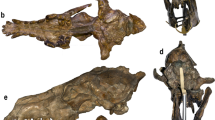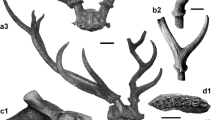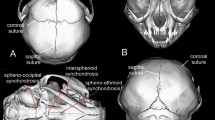Abstract
THE reconstruction by Szalay of the only known skull (CR 125, Muséum National d'Histoire Naturelle, Paris) of the Palaeocene primate Plesiadapis was presented1 as differing from previous reconstructions2–4 in the occlusal relationship of the enlarged procumbent incisors and in the relationship of the bones of the snout.
This is a preview of subscription content, access via your institution
Access options
Subscribe to this journal
Receive 51 print issues and online access
$199.00 per year
only $3.90 per issue
Buy this article
- Purchase on SpringerLink
- Instant access to full article PDF
Prices may be subject to local taxes which are calculated during checkout
Similar content being viewed by others
References
Szalay, F. S., Nature, 230, 324 (1971).
Simons, E. L., Amer. Sci., 48, 179 (1960).
Simons, E. L., Sci. Amer., 211, 51 (1964).
Russell, D. E., Mém. Mus. Nat. Hist. Nat., C, 13, 1 (1964).
Russell, D. E., Bull Soc. Géol. Fr., ser. 7, 1, 312 (1959).
Simons, E. L., and Russell, D. E., Breviora, 127, 1 (1960).
Forsyth Major, C. I., Proc. Zool. Soc. Lond., 1, 129 (1901).
Charles-Dominique, P., and Martin, R. D., Nature, 227, 257 (1970).
Le Gros Clark, W. E., The Antecedents of Man (Edinburgh University Press, 1962).
Martin, R. D., Man, 3, 377 (1968).
Author information
Authors and Affiliations
Rights and permissions
About this article
Cite this article
GINGERICH, P. Cranium of Plesiadapis. Nature 232, 566 (1971). https://doi.org/10.1038/232566a0
Received:
Issue date:
DOI: https://doi.org/10.1038/232566a0



